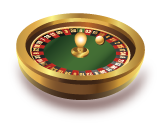Biased Roulette Wheels
Roulette is a game that has a long and colourful history. Over time, there have been 2 schools of thought on how to beat the wheels at a casino. The first involves individuals devising roulette systems to try and reduce or cancel out the house edge. And the second, is players trying to take advantage of small imperfections in the design of the roulette wheel. If a wheel is not perfectly balanced, or manufactured, it may be biased- which means to say that some sectors of numbers may drop in more frequently than others.
The second method of beating the wheel has been more successful than the 1st in the past- although tracking these imperfections becomes more and more difficult as the manufacture of the wheels becomes better and better (and the bias becomes smaller and smaller). However, take heart if you are interested in this angle, as technology is becoming more and more sophisticated, allowing a more accurate measurement of these imperfections (if you can get your tracking equipment past the noses of the pit boss and casino management that is).
Joseph Jagger playing at Monte Carlo in 1873 was probably the grandfather of these techniques. A.K.A. The Man Who Broke the Bank at Monte Carlo, Jagger tracked the behaviour of six roulette wheels at the Beaux-Arts Casino at Monte Carlo, Monaco. He found that one of the wheels showed a bias, in that the numbers 7, 8, 9, 17, 18, 19, 22, 28 and 29 dropped in more often than the others. He won £14,000 (equivalent to almost £1 million in today´s money).
Over the next couple of days , Jagger took the casino to the cleaners to the tune of £60,000 with other players in a team copying his bets. The casino moved the wheels, to throw Jagger of the scent, which worked initially. But he then found the wheel again and continued winning. In the end he won around 2 million French francs, (about £3,500,000 in modern terms), and left Monaco for good. He´d achieved the biased weel player´s dream- of working out that the ball may skew towards certain numbers, and if the skew is big enough, the payout will move over 100% on those numbers. Effectively he was playing at a money printing machine where only he knew the code. The casino, on the other hand, may as well have been burning the cash.
In the early 90s, Gonzalo Garcia-Pelayo acheived the same thing with the help of a computer. He cleaned out the Casino de Madrid in Spain, winning €600k in one day, and €1 million overall.
Obviously, the casinos are keen to reduce the risk of this happening to them, so they now monitor the performance of their wheels, and maintain and realign them frequently to try to deliver the perfect spin every time. Their technique is to try and predict the outcomes of their own wheels, and in that way they hope to keep one step ahead of the competition (ie the players trying to achieve the same thing).
British roulette wheel manufacturer John Huxley made a career out of trying to defeat the bias wheel players. He manufactured a roulette wheel, called a "low profile" wheel to solve the problem. In a low profile wheel, the pockets are much shallower and now most casinos use these types of wheels (after a player called Billy Walters won almost $4 million in the 80s on a deep pocket wheel at the Golden Nugget in Atlantic City). Huxley scooped the jackpot himself, you could say! So both the Poachers and the Gamekeepers have made money on biased wheels.
The last (reported) case of biased wheel players was in 2025 when it was alledged that a group of Eastern Europeans had used a laser scanner hidden inside a mobile phone that was then sending information to a laptop. The scam was perpetrated in a casino in London. The gang were arrested, but released without charge.

